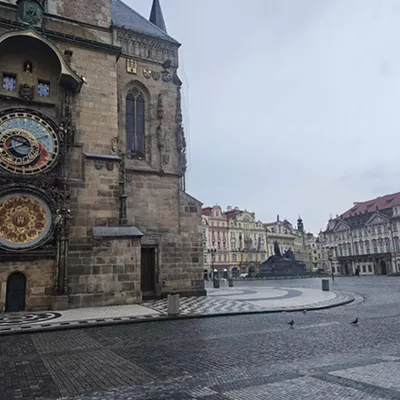Whether he heard a choir of angels, he didn't say. But when Richard Price first laid his newly retired, 66-year-old eyes on this town, he may as well have.
"When I drove across the long bridge," Price recalls, "I thought I was going into heaven. The sun was setting on the mountains and the lake, and I thought, 'This is the most beautiful place I've ever seen.' "
Price had spent the previous 27 years as a firefighter and Fire Commissioner in Novato, Calif., and he was looking for that mythical "best place to retire." Two days later, he bought a chunk of Idaho soil and called Sandpoint home.
Today, the 73-year-old Price is drinking coffee at Slates Sport Bar in Sandpoint, where he meets once a month with a group of former cops and firefighters who have also moved here from around the country. Most of the hundred or so members of the group, whose acronym is SPORTS (Safety and Police Officers Retired To Sandpoint), are from California. Mark Fuhrman is the highest-profile member of the group, although he's not real active, due to other obligations like a daily talk radio show in Spokane. He is not here today.
Jerry Benedict, one of the group's founding members, was an ATF agent and Christmas tree farmer in Kentucky before he retired here 14 years ago. His saw the area while on vacation in 1988 and decided this was it. "We were very enchanted with the community," he says. "We were only here for a few hours, but we liked it, so we sold our Christmas tree farm and moved back here."
Another member, who was an Orange County Deputy Sheriff, sums up the feelings of the group, saying, "I think we feel like we came home."
The L.A.-to-Sandpoint connection will continue, says former cop Jerry Gore. "The word is out," he says. "We've got more coming."
Price and his group are just a handful of the more than 10,000 new residents who moved into Bonner County in the last decade. That represents a 38 percent growth in population over the past 10 years in this mostly rural county that continues to average just over a thousand new residents a year. By 2025, the population of Bonner County is expected to be about 51,000. Most of the incoming are urban refugees like Richard Price who are trying to escape their previous worlds full of frayed nerves and traffic that doesn't move. They're looking for a kind of rural peace that's easily found in the hinterlands of North Idaho.
While most locals agree that the influx is good for the economy, many worry that the city of Sandpoint won't be able to support the changes that growth will bring and that the surrounding area will lose its rural charm. There's fear that visions of strip malls, box stores and sprawled-out subdivisions will spoil the splendid scenery, ultimately killing the proverbial goose that lays this area's golden egg.
Point of Sand -- This "point of sand," as explorer and fur trapper David Thompson first referred to it from his battered pine bark canoe almost 200 years ago, is now the town of Sandpoint, seat of Bonner County. With a population of about 7,000 and at about four square miles in size, it is still, by most measures, a small town. Built on the once thriving local timber industry, it has faced the same challenges of so many other small, life-after-logging-towns in the West that have been forced to transform from a resource-based economy. While hundreds of high-paying jobs were lost when mills were closing in the '80s and '90s, Sandpoint retained its most valuable economic resource: its sublime natural setting.
The town sits on the northern shore of the 43-mile-long Lake Pend Oreille and is ringed by the Selkirk and Cabinet Mountains. That's what keeps people coming. And it's the thing that makes Sandpoint one of those towns that shows up on lists in magazines like Sunset and Outside, with titles like, "10 Best Places to... (fill in the blank)."
A few examples: Two years ago, in an article in Outside magazine, entitled "10 dream towns," Sandpoint is noted for its "most beautiful scenery and most enviable outdoor recreation." Last February, SmartMoney magazine featured Sandpoint and Schweitzer for their real estate value. "If you missed buying in Aspen or Steamboat Springs, where prices have gotten unspeakable over the past 15 years, consider this ski area 50 miles from the Canadian border... It's not just another Swiss Miss copy of the Alps." Even a publication devoted to the New Age and eco-spirituality crowd, Intuitive Flash, mentions Sandpoint in its "10 Best Places To Live," noting the area has "a strong yellow vibration." This, supposedly, is a measure of the type of energy that draws people with higher levels of intellect and consciousness.
Landing on such lists is flattering, to be sure, but it's also the civic equivalent of a storm forecast. Clouds of people are coming.
Will Sandpoint, a contrary little burg in a lot of ways, be able to weather the storm? Here's a city that posts signs at the entrance of town that say it's a "walking town," yet it has a major highway stabbing through its center. Pedestrians risk life and limb when trying to cross the main street. It's a town whose stunning natural setting is also called the "sucker view" because when people first see it, they want to quit their jobs and move here. Blinded by the beauty, they're suckered into believing they can make a living in a place with 8 percent unemployment and an average annual wage of $23,000. It's a city that, with its lake and mountains, can provide an idyllic, Huck Finn existence for kids to grow up in. But it can't provide the jobs that will keep them here after graduation. It's a place whose local officials were once described by an outside consultant as "a group that, when there's trouble, they circle the wagons and shoot inward."
Now, however, things may be changing. Whether moved by a "strong yellow vibration" or a fear of being "Aspenized," there is a renewed sense of energy and urgency at work in Sandpoint, as public officials and concerned citizens work to improve the local economy and protect the area's traditional way of life. Consider the following:
* Last year, the city funded an eight-month study by on outside consultant to help save its downtown, the results of which sparked a new downtown revitalization plan.
* There's been a groundswell of grassroots groups with words like "smart growth" and "sustainability" in their names, which are organizing forums and workshops to talk about such concepts.
* The city just enacted a resort city tax to generate $150,000 a year for five years to help pay for the impacts of tourism. (Two motel owners sued, claiming it was unconstitutional.)
* Last Fall, the Panida Theatre was packed to capacity for several showings of a new film commissioned by the city of Sandpoint to help celebrate its recent centennial. As one viewer said, "it just made you feel good to live here."
* The county is updating its comprehensive plan for the first time in 25 years.
* Discussions continue about the controversial Sand Creek Byway, a $45 million project that proponents say will help manage downtown traffic by rerouting it along the banks of Sand Creek east of town. Opponents say it will create a ribbon of noise and destroy a fragile environmental area. Downtown business owners, who don't much like the traffic, worry that it will hurt their sales as motorists may never see their storefronts.
* Local business and government leaders are negotiating with Salmon Air to start daily commuter airline service to Seattle and Boise.
City Planning -- Stephen Drinkard's job title is City Project Coordinator. He wrote the grant that funded that eight-month study to look at the city by a firm called the Hingston Roach Group. "What they said is that we are untapped," Drinkard explains. "That we have not done the work needed to realize what we can do."
That study kicked off a five- to-seven-year downtown revitalization plan that will focus on two key areas: its physical infrastructure and its marketing and business development. Among the challenges the study identified was a lack of a cohesive image and a lack of consensus about the future.
The study also said the city needs a heart, a town center where people can gather. So there's a $1.5 million project underway to create a gathering place downtown. People who see the downtown often say it's too touristy, with too many real estate offices, art galleries and For Lease signs.
"Everybody wants that downtown that existed in the '50s," says Constance Buxton, director of the Downtown Sandpoint Business Association. "They don't exist anymore. And if they do, they're struggling. There are a lot of people here who are trying to make a difference. What I see is new faces in old places. And if we all do this together, perhaps this will all come true."
Buxton adds that what everyone does agree on is the value of the historic Panida Theatre. "The Panida, I would say, is the evening star of downtown. They do a wonderful job of bringing entertainment and life into a small downtown."
So what kind of town is Sandpoint? That depends on who you ask. You'll hear that it's an arts town, tourist town, hippie town, ski town, logging town or New Age town. It's a town that's become known as an arts and cultural mecca. It's a town that's home to a music festival that Spokane can only dream of. It's a town with more ski racks than gun racks. And it's a town whose ethnic makeup is 97 percent white. In the new film, Sandpoint at the North End of the Long Bridge, lifelong resident Marianne Love agrees that while the area has little ethnic diversity, it has a great diversity of thought and opinion. Such diversity will be needed as Sandpoint decides where to go from here.
What is Rural? -- As a Bonner County planner, Clare Marley hears a lot of different opinions on how and where the county should allow for growth. But she says there is one common thread of consensus. "As our population increases, we continue to hear that the number one interest is to retain the rural nature of this county. The challenge we're charged with is trying to figure out how you do that while you're still able to grow."
Love is a lifelong Sandpoint resident, an author and a recently retired schoolteacher. She lives on 10 acres just west of town, where she also keeps horses. She's noticed more development around her land in the last 10 years. "I used to live outside of town," she says, "but now my little 10-acre farm feels like I'm in town. I'm noticing growth all the way around me. I'm a wide-open-spaces-type person, and it feels a little encroaching. It's encroaching in a way that there used to be lots of open space, and now there isn't. It looks to me like my little rural hideaway is going to be disappearing very soon."
Love says she's also saddened to see the family farms becoming a thing of the past. "They are being replaced by five- and 10-acre plots, and those are being replaced by subdivisions where there's several houses on one five-acre plot. That's been the thing that's been really visible."
"I think the thing people don't realize about our county is that we are already quite well subdivided," says Marley. "They see wide-open spaces and they don't realize how divided we already are. There are about 37,000 to 38,000 single parcels and lots in this county of 37,000 people. That's one per person. We have a lot of public land, so that gives the impression of being more wide-open. But our private lands are already fairly well divided."
"Bonner County is not rural, not with the countryside cut up into five-acre tracts," says Marty Taylor, who was the Bonner County planning director between 1994 and 2002. "Rural is more like the 40-acre-plus tracts. It's just not developed yet. That's an important distinction."
Even more to the point is Guy Bailey, executive director of the Selkirk Conservation Alliance, when he says, "The county is ready to be carved up into tiny pieces and just built to hell."
Does Tourism Pay? -- Thomas Power is an economics professor at the University of Montana in Missoula and author of Lost Landscapes and Failed Economies, in which he examines towns with failing traditional economies like Sandpoint. He argues that the key to a vital and diverse local economy lies in maintaining the natural landscape and integrity of the community. He says that relying too heavily on tourism and commercial resort development often pays few dividends and that increased growth in an area doesn't necessarily mean increased wealth.
"Over here in western Montana, we've seen growth, growth, growth, but it hasn't raised average income or average pay," Power says. "There's no evidence it's made people better off."
"Suggesting that everything that's going on in Sandpoint is tied to a resort like Schweitzer is like saying that everything going on in the Coeur d'Alene area is tied to Hagadone's resort," says Power. "It's just a small part of a much more complex change taking place where people are pursuing what they perceive to be a higher-quality living environment to settle in. Every resort town I'm familiar with -- Aspen, Telluride, Jackson, Steamboat Springs -- all of these towns are wrestling with how to keep from becoming just a resort town. How to keep the town an attractive place for permanent residents is how to have a real economy. But that probably involves not giving the state away, the town away, the lake away to the resorts."
Tom Fortune, general manager of Schweitzer Mountain Resort might disagree. He says Schweitzer, just 12 miles from Sandpoint, provides about 600 jobs during the winter and about 125 each summer. "I think we are an economic engine for the community," he says. "We have about $3.5 million a year in payroll and a lot of that stays right here in the community."
The Seattle-based Harbor Properties bought Schweitzer in 1998 and immediately began making multi-million dollar improvements to the 7,000-acre resort. The new White Pine Lodge was just completed this summer at a cost of $15 million. During construction, it employed about 80 people; with the completion; it provides about 30 permanent jobs. The seven-story lodge, with its 50 condominiums and various shops, is the heart of the new Schweitzer Village.
Growth and Jobs -- While the number of jobs grew at about the same rate as the population, unemployment still hovers around 8 percent in Bonner County. That's higher than both the national and state averages.
"Bonner County is the most dynamic county in the state," says Kathryn Tacke, regional labor economist for the state of Idaho. "It has the greatest swings in job growth and in job losses when the mills were closing."
Tacke says an influx of new residents is both a blessing and a curse on the job market. "It creates jobs in construction, retail and government agencies, but at the same time it creates competition for jobs in other areas, which lowers the wage rates."
This explains the waitress-with-master's-degree phenomenon in many resort towns. Tacke says that Sandpoint, however, is starting to see a greater variety of well-paying jobs. "It sometimes surprises me how sophisticated some of the jobs there are in that community, relative to its size."
Low wages are not a problem if you're lucky enough to catch on at Coldwater Creek. The locally grown business's average wage is more than $40,000 a year. Dennis Pence, the company's president, founded the company 19 years ago with his wife, Anne, when they moved to Sandpoint from New York City.
"We moved here because we loved the outdoors," says the 53-year-old CEO. "We wanted to live in the mountains. No thought was given back then that the company would grow to its current size of nearly a half-a-billion dollars in revenues."
Pence had to close the distribution center in Sandpoint because it became too expensive to ship products from such an isolated location. Although that closure meant the loss of about 120 jobs, Pence says the national corporate headquarters is staying in Sandpoint. He stays for the quality of life it affords him and his employees. "We're able to attract employees to Coldwater Creek partly because they wanted a less urban existence. Traffic in Chicago, New York and L.A., with two-hour commutes -- it was not a lifestyle that was conducive to sanity."
Smart Growth -- Growth is not a new topic in Sandpoint. Like bell-bottoms and lava lamps, it never really goes too far away -- it just recirculates in and out of fashion. And right now, talking about growth issues is back in fashion. Community activism is on the rise, and there has been an increase in public forums and community discussions. New groups are sprouting up to address all the different issues, such as traffic, sprawl, overdevelopment, environmental impacts, affordable housing, public education, wilderness preservation and sustainability.
Becky Kemery is the organizer of a group called Foundation For Life. She organizes monthly presentations on sustainability. "A lot of people involved are people who have recently moved up here," says Kemery. "It feels like there's a lot of energy around the subject now -- a lot of people wanting to do something."
Guy Bailey's Selkirk Conservation Alliance co-sponsored a number of Smart Growth forums back in November. He says he wanted to engage the community in deciding where it wants to grow from here. "People are hungry for some leadership in the community outside of the traditional lines such as county planning and zoning."
Bailey says he's seen what can happen with too much growth. "I left the last two places I lived because of unrestrained development destroying the aesthetics and the environment."
And sometimes the big picture is too big to engage people. Often it's the issue in their backyard that first sucks them into the discussion.
Marsha Gilbert moved to East Hope two years ago from Colorado. From her Zen-themed living room in her hillside home she can look out at the expanse of Lake Pend Oreille and see bald eagles fishing. Since moving here, she has immersed herself in a number of community activities, but as an avid kayaker and birder, there is nothing she's more passionate about than preserving the Pack River delta on the northern tip of Lake Pend Oreille. When Hidden Lakes Golf Resort proposed to build a dock a few miles up the Pack River and use it to shuttle guests in motorized boats up the meandering river, she got involved. "The Pack River does not belong to Hidden Lakes," she says. "It belongs to all of us."
Now that she's become involved in a land-use issue, Gilbert sees the potential environmental costs of overdevelopment all across the landscape of Bonner County.
"Things are changing here," Gilbert says, "and the thing that makes this place remarkable will be gone in 10 years if we're not careful. This is happening so fast in front of our eyes that we have to wake ourselves up and see it and deal with it."
Comments? Write us at letters@inlander.com
Publication date: 02/13/03














